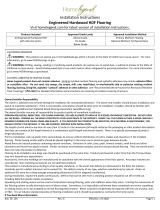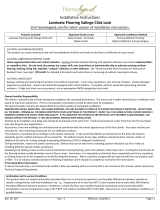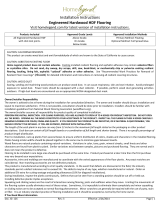Page 3 of 10
Basements and Crawl Spaces
Concrete slab or ground must be dry. The ground in the crawl spaces must be completely covered using 6 mil black polyethylene.
Crawl
space clearance between the earth and underside of joists should be no less than 18 inches and the perimeter vent area
should be equal to 1.5% of the total square footage of the crawl space or as mandated by code.
Concrete Subfloor Requirements
It must have minimum rated strength of 3000 psi.
It must be flat. It should be flat to within 1/8” in a 6-foot span; no bumps or low spots. High spots can be removed by grinding;
depressions
can be filled with patching compound formulated for use in floor installation.
It must be clean; no construction debris, soil, mud and any other objects on/or adhering to the floor; if necessary, scrape and sweep
away
before the installation; no protrusions of nails, debris, metals should remain.
New concrete slab must cure for at least 60 days. It must have a minimum 10-mil polyethylene sheet between the ground and the
concrete.
It must meet concrete moisture requirement below.
It must be free from moisture related conditions which can damage the installed flooring.
Light Weight Concrete
It is concrete which rated strength is less than 3000 psi.
Perform a quick check by drawing a nail across the top; if it leaves indentation, it is probably light concrete.
For glue-down application, the concrete must possess shear strength greater than the glue. If concrete rated psi is unknown, contact
the
adhesive manufacturer for guidance.
Concrete Moisture
All concrete subfloors should be tested for moisture content and the results documented. Visual checks are not reliable. Perform tests
at
locations around exterior doorways, near walls containing plumbing, near foundation walls and in the center of the room.
Minimum sample
size is 3 per 1000 square feet of area and one test for every additional 1000 square feet thereafter.
Its moisture content should meet one of the following criteria below:
•
4.5% when tested using Tramex Concrete Moisture Encounter.
•
Less than 3 pounds per 1000 square feet per 24 hours when using Calcium Chloride test (ASTM F 1869).
•
75% when using Relative Humidity Testing (ASTM F-2170).
Please note: Concrete moisture content may be acceptable the time of the test but these tests do not guarantee a perpetual “dry”
concrete
slab. The concrete slab moisture content can vary at other times of the year. We are not responsible for moisture related
damage to installed
flooring.
Wood Subfloor Requirements
It must be clean; no presence of construction debris, soil, mud and any other objects on or adhering to the floor; no protrusions of
nails,
debris, metals should remain. If necessary, scrape and sweep the subfloor before the installation.
It must be structurally sound and stable: no movements or squeaks, no loose panels or loose nails, no signs of ply de-lamination or
other
damages. Repair all shortcomings before installation.
It must be flat with no visible bumps or low spots; the subfloor should be flat to within 1/8” in 6 feet span.
Test for moisture using reliable moisture meter. Perform tests at locations around exterior doorways, near foundation walls, near walls
containing plumbing lines and in the center of the room. Measure 20 locations per 1000 square feet.
Moisture content of subfloor should be less than 12%.
Moisture content difference between subfloor and acclimated flooring should be 4% or less.
Plywood or Oriented Strand Board (OSB) Specifications
On truss/joist spacing of 16” (406mm) O/C or less, the industry standard for single-panel subflooring is minimum 5/8” (19/32”, 15.1
mm) CD
Exposure 1 plywood subfloor panels (CD Exposure 1) or 23/32” OSB Exposure 1 subfloor panels, 4’ x 8' sheets. Expansion gap
between panels
should be 1/8” (3 mm). If panels are not tongued and grooved and there is not sufficient spacing or is inadequate, cut
in the required spacing
with a circular saw. Do not cut in expansion space on tongue and groove panels. If truss/joist spacing is 19.2"
apart then minimum thickness
of plywood or OSB panels is 23/32". If truss/joist spacing is larger than 19.2" apart then minimum
plywood thickness is 1" and minimum
thickness for OSB is 1.125". If the substrate does not meet these minimum guidelines then
add 1/2" of plywood to the substrate before
proceeding.
Particle Board or Fiber Board
Only for floating installation.
















